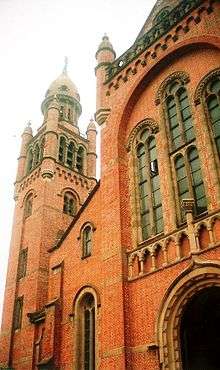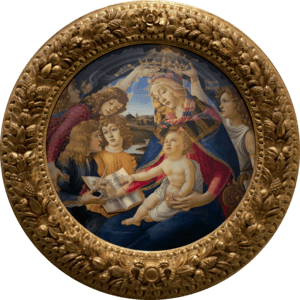Sheshan Basilica
| National Shrine and Minor Basilica of Our Lady of Sheshan | |
|---|---|
| 佘山進教之佑聖母大殿 | |
|
View of Sheshan Basilica | |
| Basic information | |
| Location | Shanghai, China |
| Geographic coordinates | 31°05′47″N 121°11′16″E / 31.0963234°N 121.1878821°ECoordinates: 31°05′47″N 121°11′16″E / 31.0963234°N 121.1878821°E |
| Affiliation | Roman Catholic |
| District | Diocese of Shanghai |
| Ecclesiastical or organizational status | Minor basilica |
| Architectural description | |
| Architectural type | Church |
| Architectural style | Romanesque |
| Groundbreaking | 1863 |


The Sheshan Basilica, officially the National Shrine and Minor Basilica of Our Lady of Sheshan (Chinese: 佘山進教之佑聖母大殿; pinyin: Shéshān jìnjiào zhī yòu shèngmǔ dàdiàn) and also known as Basilica of Mary, Help of Christians[1] is a prominent Roman Catholic church in Shanghai, China. Its common name comes from its location on the western peak of Sheshan Hill, located in Songjiang District, to the west of Shanghai's metropolitan area.
It was previously romanized as Zosé Basilica (pronounced "Zoh-seh"), using the Shanghainese pronunciation of 佘山 (Sheshan). Inside the shrine, the Blessed Virgin Mary under the title of Mary Help of Christians is venerated as the patroness of the basilica,[2][3] along with the recently reconstructed icon of Our Mother of Sheshan, both venerated by Chinese Catholics.
History
The first church on Sheshan hill was built in 1863. During the Taiping Rebellion, Jesuit missionaries bought a plot of land on the southern slopes of the hill. A derelict Buddhist monastery had stood on the site. The remaining buildings were demolished, and a small building was constructed as living quarters for missionaries, and a small chapel. At the peak of the hill (where the Maitreya hall had stood), a small pavilion was built in which was placed a statue of the Madonna.
In June 1870, unrest in Tianjin led to the burning of churches there. The Shanghai Jesuits prayed at the statue of the Madonna and pledged to build a church to her honour in return for her protection. Subsequently, construction of the church began. Wood was shipped in from Shanghai, and stone bought from Fujian. All material had to be ported to the peak by hand. The church was completed two years later. This first church was in the form of a cross, and incorporated features of both Chinese and Western architecture. A veranda was placed outside the door, with ten columns. Eight stone lions were placed before the church. In 1894, several ancillary buildings were added. These included a chapel halfway down the hill, a shrine to the Sacred Heart, the Virgin Mary, and St. Joseph. Fourteen Stations of the Cross were constructed along the path to the church.
In 1925, the existing church was found to be inadequate, and it lagged far behind other churches in Shanghai in terms of size and ornamentation. The church was demolished and rebuilt. Because the Portuguese priest and architect Ye Zhaochang (叶肇昌) was very stringent about the quality of construction, the whole project took ten years to finish, and the church was completed in 1935.
In 1942, Pope Pius XII ordained the Sheshan Cathedral a minor Basilica. In 1946, the Holy See crowned the statue of Our Lady of Zosé at the apex of the tower.
During the Cultural Revolution, Sheshan Cathedral was severely damaged. The stained glass windows of the church, carvings along the Via Dolorosa, the statue atop the bell tower, and various other works of iconography were destroyed.
In the 1950s, Ignatius Kung Pin-Mei the Roman Catholic bishop of Shanghai was arrested and imprisoned for over 30 years and the Chinese government put the basilica under the control of the Chinese Patriotic Catholic Association and Chinese bishops not recognized by the Vatican, and condemned by the papal encyclical Ad Apostolorum principis.[4]
After the end of the Cultural Revolution in 1976, the damage was gradually repaired. The statue was initially replaced with a simple iron cross, and a replacement statue was installed in 2000.[5]
On May 24, 2008 Pope Benedict XVI announced that he had composed a special prayer for Our Lady of Sheshan.[6]
Layout
The church occupies an area of 1 hectare and is about 70 feet (20 m) tall. It is a rectangular Latin cross in shape, and in classical basilica form. Entrances are placed in the north, west, and south. The main door is in the south-west. The nave is 55.81 m long, 24.68 m wide. The ceiling is 16.46 m high, and the church can seat 3000. The altar is placed at the eastern end, and is built of marble with gold trim and in-laid jade. The exterior is mainly granite, and part of the roof is covered in Chinese-style color-glazed tiles.
The bell tower stands on the south-east corner. It is 38 m tall. At the top of its bell tower stands a 4.8m bronze Madonna and Child statue ("Our Lady of Zosé").
Other features
The 14 Stations of the Cross are situated at the end of each zig-zag path up the steep hill leading to the church. At the mid-level in an open square where there are two shrines, one in devotion to the Sacred Heart and the other to the Virgin Mary.
Nearby is the She Shan Station of the Shanghai Astronomical Observatory. This was originally built by the Jesuits.
Pilgrimage
In 1874, Pope Pius IX declared that pilgrims who went to She Shan in May (traditionally a Marian month) would receive a Plenary Indulgence. As a result, pilgrims from all over China began to congregate at She Shan in May, a practice that continues to this day.[7]
Every May, the church becomes the destination for pilgrims who travel far and wide to make their annual pilgrimage at She Shan, praying the Way of the Cross, the Rosary and attending Mass at this holy site. Traditionally, many of the Catholics in the area were fishermen, who would make the pilgrimage by boat. This tradition continues among local Catholics, with the result that the creeks around She Shan are often crowded with boats in May.
See also
References
- ↑ http://www.gcatholic.org/churches/asia/0599.htm
- ↑ http://www.asianews.it/files/Image/sheshan/IMG_7122_b.jpg
- ↑ The main altar of the church enshrines a large statue of Our Lady Mary Help of Christians, which is also distributed in its religious pamphlets and event notices.
- ↑ Papal encyclical Ad Apostolorum principis
- ↑ http://www.ucanews.com/story-archive/?post_name=/2000/05/05/bronze-marian-statue-installed-at-sheshan-basilica-in-shanghai&post_id=15948
- ↑ Catholic News http://www.cwnews.com/news/viewstory.cfm?recnum=58489
- ↑ http://www.ucanews.com/story-archive/?post_name=/2000/05/05/bronze-marian-statue-installed-at-sheshan-basilica-in-shanghai&post_id=15948
External links
| Wikimedia Commons has media related to Sheshan Basilica. |
- "Our Lady of Sheshan" on the website of the Cardinal Kung Foundation
- "Prayer of His Holiness Benedict XVI to Our Lady of Sheshan on the occasion of the World Day of Prayer for the Church in China" on the website of the Vatican


